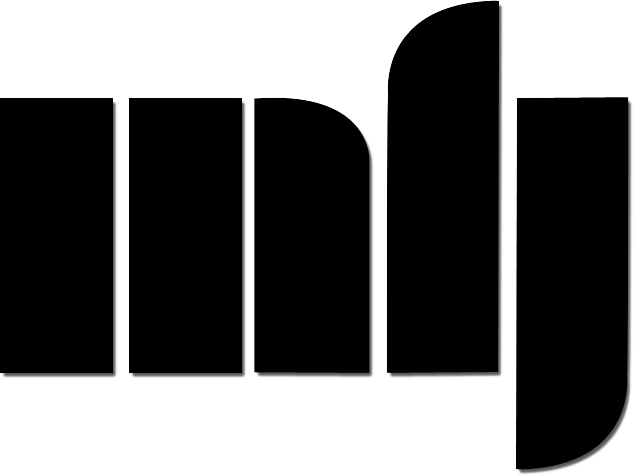Between the analytical and the sensorial, Film as conceptual performance: A conversation with Anthony McCall
Anthony McCall has been making films since the 1970s. His early films started out by complicating the role of film as a mode of (passive) documentation, of landscape performances in his case. Unlike the uninterrupted nature of video art which at an initial stage combined self-expression with real time feedback, McCall’s early foray into film takes cognizance of the classical plastic properties of the medium in the manufacturing of what one might call a filmic time. Drawing inspiration from the Happenings movement, the binding interest for all of McCall’s films is performance. However what changes between the early short films and the solid light works beginning with Line Describing a Cone in 1972, after he moved to New York from London, is the shift from articulation of performance as a profilmic event to Film projection as an act of autonomous performance. Over a duration of 30 minutes, Line depicts the gradual formation of a white circle against a black background. The film-performance abandons the spatial conventions of a cinema and allows the audience to experience and interact with the phenomenon of projection rather than the projected image. In doing so, the beam of light, frequently made palpable by smoke, but from a haze machine nowadays, activates a three dimensional sculptural space between the projector and the two dimensional projection surface, often becoming the center of attention. In subsequent solid light films, McCall has varied scale, duration, textures and shapes of the projected light to explore different spatial and spectatorial relationships of the event to its environment and audience. After finishing the last of the solid light works in 1975 (to which he would eventually return in the 2000s), McCall made two collaborative films, Argument (1978) and Sigmund Freud’s Dora (1979), that remain in active dialogue with the Marxist concerns of image politics and the psychoanalytic turn in Feminist film theory. After working for 25 years as a graphic designer in the interim, McCall came back to filmmaking in the early 2000s. The dematerialized and conceptually rigorous nature of his practice that often followed outlining and elaborating on an idea in his notebooks, meant that the shift from film to digital, both in terms of restoration of his earlier works and production of new works, could be relatively seamless. Having operated largely within the context of Avant Garde filmmaking of the 1970s until now, McCall’s return was emboldened by the new found acceptance of moving images in art galleries and museums. Even here, McCall’s conceptualism counteracts the highly fashionable immersive audiovisual works and realistic documentary trends that continue to gain in prominence. As Avant Garde film continues to become more of a category from the past within critical discourses, McCall’s solid light works have naturally gravitated towards art exhibition spaces. It was therefore somewhat of a surprise, albeit a pleasant one, when S8 Mostra de Cinema Periférico in A Coruña, Spain, a festival devoted to analogue oriented experimental film, invited McCall for two programs of his works this year, one of which was a selection of the solid light films alongside a lecture-presentation by him. The conversation that follows took place in June during the festival.
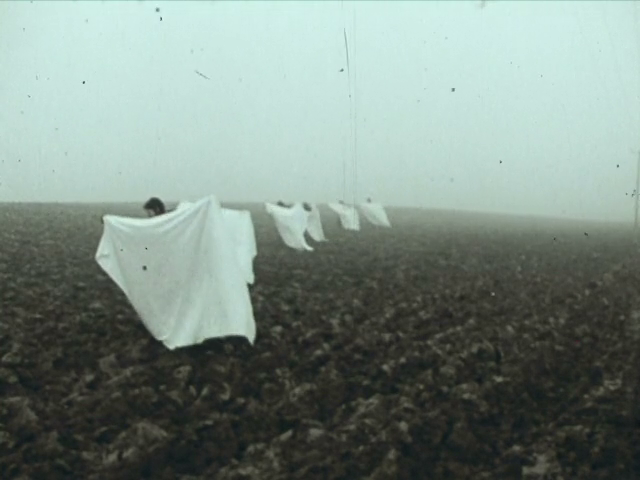
Arindam Sen: Your first films from 1972, Earthwork, Landscape for White squares, Landscape for Fire come at a moment where film was becoming increasingly popular with artists who were using it as a form of documentation that would either help them to transport the art works to galleries and museums (Robert Smithson and Nancy Holt, Gordon Matta Clark for example) or in the case of time bound performances/interventions (Judy Chicago, Joan Jonas, Christo and Jean-Claude), as a record for posterity. In Britain, Barry Flanagan was making films. All of these artists along with others, and their films, featured with the three films you made as part of the Ends of the Earth: Land Art to 1974 exhibitions in 2012 at MOCA Los Angeles and later that year in Haus der Kunst, Munich. Can you revisit some of the contexts of these early films?
Anthony McCall: It is interesting that at that moment a lot of artists were beginning to approach the media as a legitimate part of what they did. I think it really comes out of Conceptual art. Conceptual art is a sort of overarching category and it was a time when the medium you selected to work with was not of such great consequences as it was a generation earlier. There was a show at the ICA on Expanded cinema in 1976, and in there, I am on record saying that I prefer the general term artist to filmmaker because it doesn’t presuppose any particular medium or approach. I still feel that way and it has become something of a default position. Among younger artists, it’s unusual to find someone who sticks to a medium. As a young artist, the word that covers everything is, “performance”, in one way or another. And that was partly inspired by my partner Carolee Schneemann and partly by my interest in the Happenings movement and Judson dance, where performance meant executing a task, it didn’t mean performing in any traditional sense. And that struck me as a very productive idea. Yvonne Rainer and Simone Forti were involved in that sort of task orientation. I was also inspired by the ideas of John Cage. It didn’t seem much of a stretch to film a performance because I had already discovered that film was quite unpredictable, Landscape for Fire turned into what I would consider a work of art, it was not a documentary and that’s true of Earthwork which is about as tight a narrative that you can get in a minute and a half. It was nothing whatsoever like the artists’ video, nothing at all. The artists’ interest in video at that time was in picking it up for its ability to just stare at something. With the early video, there were no editing facilities. Portapak was just a format, a very heavy one, much heavier than a film camera – not often mentioned that fact, it weighed about 70 pounds. And so working with video usually meant using video as a means of simply watching something happening. A very good example would be Bruce Nauman’s work. Whereas I was making films, I didn’t have a category for myself but I knew that I was exploring the use of film. I had learnt to edit and it was soon after that I became aware of and interested in avant garde cinema, paradoxically through reading. The book that first revealed to me this new world that I knew nothing of was David Curtis’ Experimental Cinema (1971). There I read about Wavelength (Michael Snow, 1967), and Warhol’s films and was immediately influenced and inspired by that reading. I hadn’t actually seen them. I saw Wavelength years after I made these Cone films and was quite put out because it was not nearly as pure as I had imagined- the simple execution of the perfect idea. It was instead quite messy. A lot goes on in Wavelength which was not described in the textbook. From Warhol I took the idea of the stare and the idea of the camera as a provocation which is very interesting. But I was pulling these influences out of the air because I needed and wanted them, it was not purposeful at this point. I was also aware of the London Filmmakers Co-op, which I attended and which at the time was under the sway of Malcolm LeGrice and Peter Gidal. Gidal’s quite militant politics vis-a-vis narrative and Hollywood cinema was explicit and he in a way demanded the end of images made by identification-oriented narrative cinema. All these ideas I was absorbing at quite a high rate in the early 1970s. Landscape for Fire was a pretty good film about a performance, but it was still a film about something else, which for me was the primary thing- the performance. And I began to wonder if it was possible to make a film that was itself a performance.
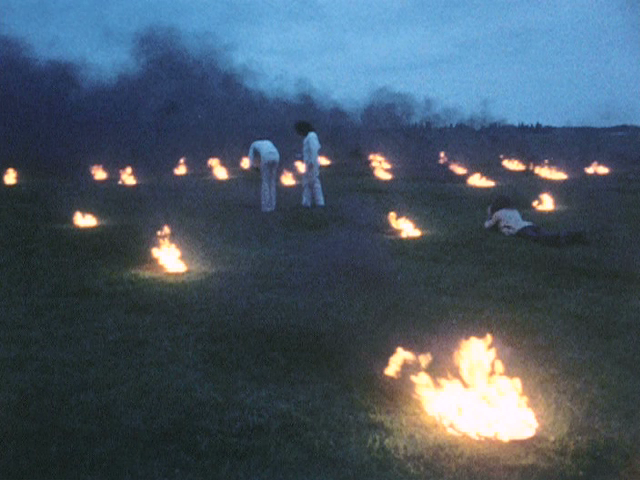
AS: Wavelength seems to be a key film for many artists at the time including Richard Serra and Robert Smithson. Landscape for Fire makes me think of Spiral Jetty (Robert Smithson, 1970), the film, for two reasons, the aerial shots in Landscape for Fire and for making explicit the fact that a film was being made.
AM: The aerial shots in Landscape for Fire were improvised, everything was improvised to tell you the truth. There weren’t any rehearsals for these pieces. In this World War II aerodrome we were able to use, there was a deserted control tower and it seemed natural enough to put a camera on top just to watch everything from above. Having the filmmakers in the film was also obvious given that we had no rehearsals, I always made a score, although it was a loose one, it seemed so much simpler to mix everything up. So there were the performers and there were the filmmakers and it was interesting to incorporate both in the same work of art.
There was never any confusion, nor was there any need for confusion, it was just that they were simultaneously present. I always liked that aspect of the film.
AS: What guided the durational, structural and spectatorial decisions for the performance of Landscape for Fire?
AM: I thought of the audience as a witness to a task, an event being executed. And it was something of a shock to discover that there were some people who were quite disappointed, clearly expecting something like a firework display. Having used a carousel slide projector for three works in 1972, I had already got used to the idea that a work could be cyclical, that there was absolutely no need to have a beginning and an end but rather a continuity in time. I gained the idea of repetition from a poet friend of mine – Anthony Howell, who was experimenting with permutation as a composition tool in his way of approaching Gertude Stein; which I was much struck by. It meant that you could organize work in time without invoking narrative. To do the full permutation of the longest fire work performance that was 13.5 hours long, meant structuring the work without having to give reasons, it was hugely productive for me and I continue to use it although not quite as obvious as before. I tried to outflank the problem of the audience by removing the audience and changing it to the “visitor”. If you have a continuous work in effect looped like a carousel projector work is, you don’t have to worry about where it is going.
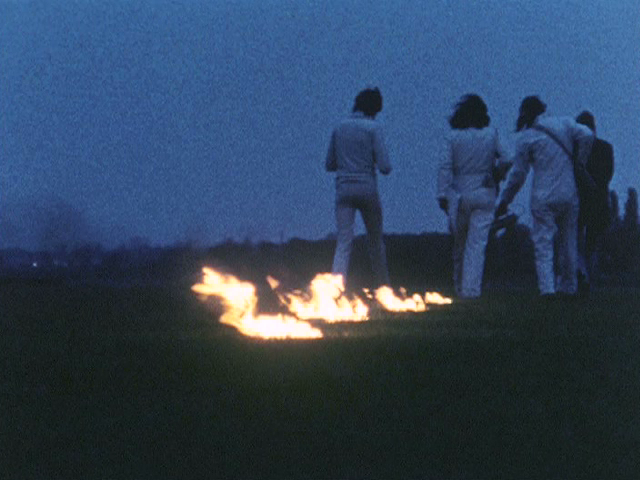
AS: Who produced Earthwork and Landscape for White squares?
AM: The short works, Earthwork and Landscape for White Squares, were done as part of a single project. I intended to make five of them, they are all in my notebooks, complete with storyboards. This is one of the curious things that happen from time to time: I was approached by a BBC producer who had somehow come across Landscape for Fire and he was in charge of a children’s program where he thought it would be interesting to have a few two minute films by me, something that could be interjected into the flow of his program. A program I never saw and a man I didn’t know. He proposed to pay £100 for each of the films or something. I took on the task and I finished a few works which I recognise as proper works and others that probably were less impressive. I had quite specific ideas about what they all were. Again, this was filmmaking, where I had outlined different shots and which I followed like a shooting script. This wasn’t true for Landscape for Fire which was more improvised and didn’t have that structure by the time it was made into a film. It was fragments and the segment near the end, where the person runs away backwards into the distance, was just a kind of cutaway we had made. I always like that moment because at the end you’re left with a 4:3 ratio screen with a white dot, which is exactly the starting point for Line Describing a Cone. This was a happy coincidence.
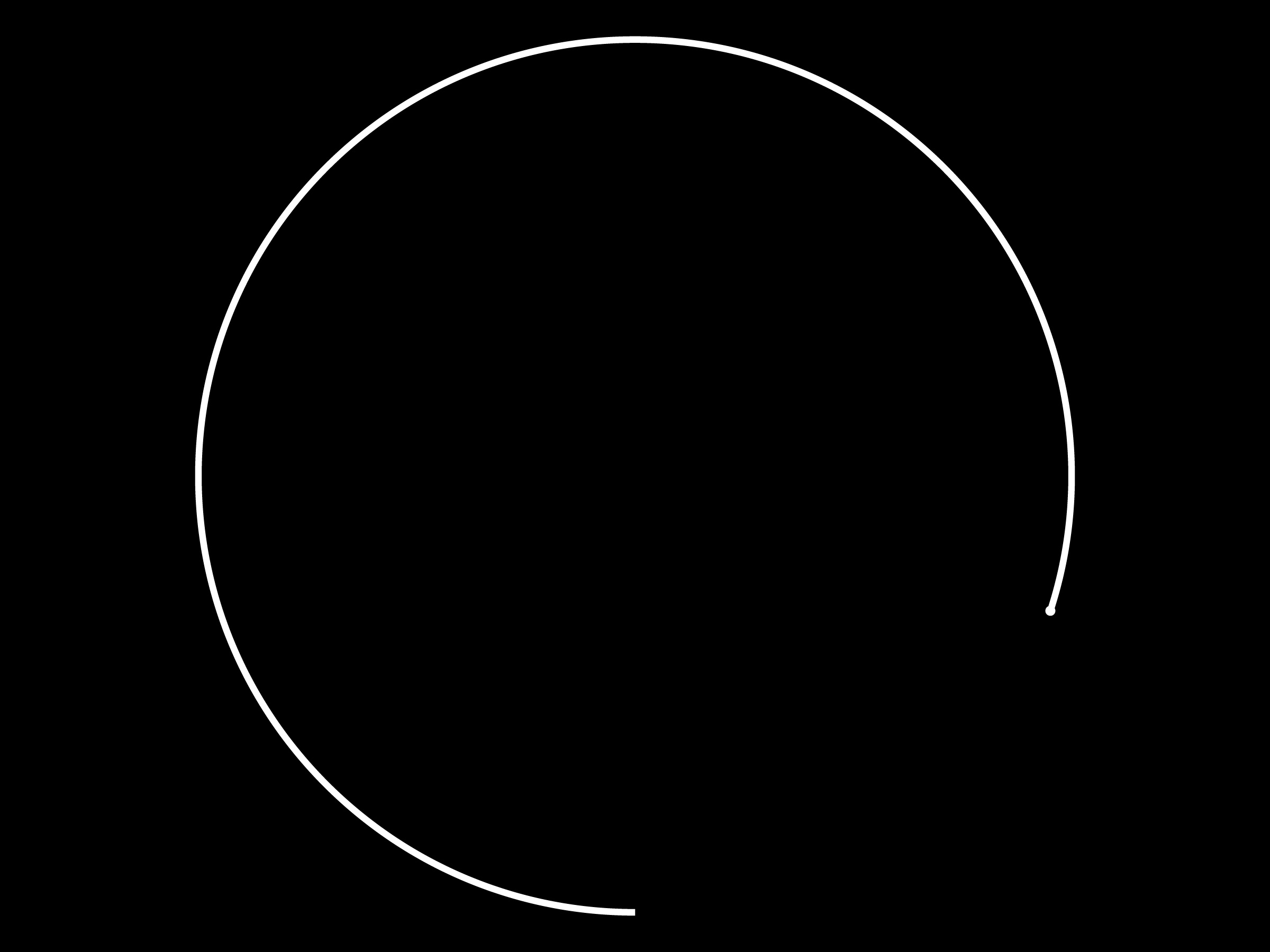
AS: For the Solid light works, the immediate context is set by the time period to which they belong, a late modernist period with links to Minimalism, Structural film, Expanded cinema and Conceptual art. Perhaps somewhat of a less obvious but nonetheless prominent connection, that Hal Foster has written about, is to constructivist artist László Moholy-Nagy and his modernist quest for dematerialisation primarily through film and photography, which is antithetical to much of the impetus on medium and process in the 60s.
AM: I think I have been aware for a long time of Maholy-Nagy’s Space-Light-Modulator (1930). I had seen it at Tate and I had known about it earlier. There was also a big exhibition of his work at the Guggenheim only a few years back. I couldn’t say he was an influence but I was aware of the fact that he was dealing with the medium that I was working in at the time- photography. I went to art school but I wasn’t in the painting department, which is just as well, I don’t think I would have been happy there at all. The things that I studied were typography, photography and philosophy. Maholy-Nagy’s work somehow showed that you can make art without being a painter, painting was of course this dominant discourse. Maholy-Nagy also represents the Bauhaus approach to art in the 20th century leading to Conceptual art whereas Picasso leads somewhere completely different, he is recognised in the tradition of painting. So these things are dimly articulated in the background.
AS: What conceptual ideas in spatial terms informed Long Film for Four Projectors (1974) and Four projected movements (1975) (you called the latter a precis in your interview with Scott MacDonald)?
AM: Four projected movements is a precis of a much more complex film that is Long Film for Four Projectors. It’s hard to start off by explaining a complex film before you get the simplicity of the idea. It’s about the agency of the projector, to change what you are seeing in sculptural space. In Line Describing a cone, even though I succeeded in having the audience turn their back to the screen, I still had a single axis running through space. Four projected movements succeeded in changing that conversation to sculptural space and Long film succeeded I think in presenting the space that film existed in, as a “field” that you couldn’t escape from, and where you were surrounded by intersecting beams of light passing through space, and one another, in every direction. The only way in which you can leave that film is by walking out of the room. It’s also how I still think about the pieces that I am making now. Everything is in space rather than on the wall. Four projected movements is quite easy to project and Long Film is quite complicated. These days getting four matching xenon lamp projectors is not easy, fifteen years ago when I showed it in France under the auspices of Centre Pompidou, they got their four xenon lamp projectors from all over France.
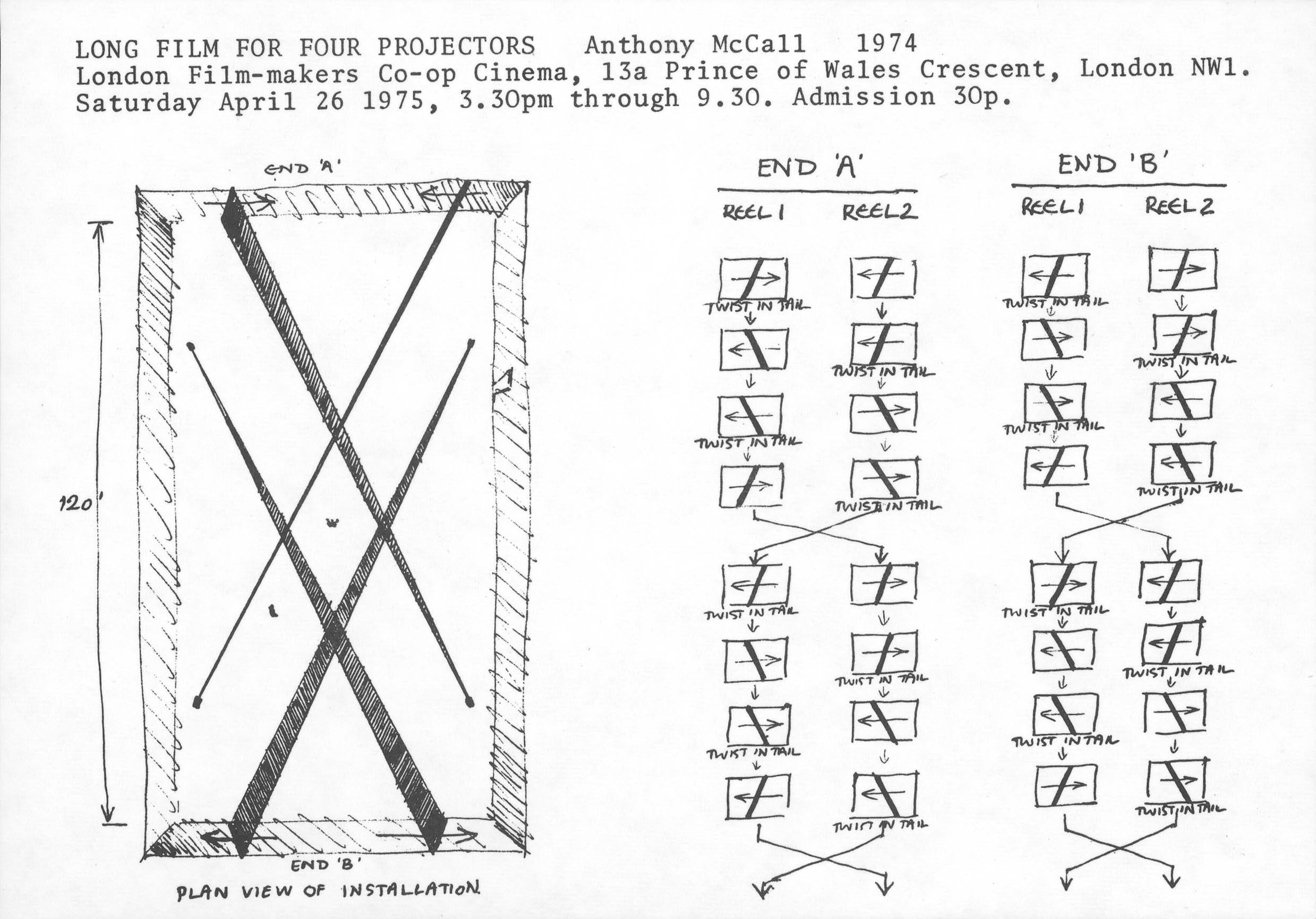
AS: You have now digitized these films. How did you adapt?
AM: Nowadays the issues have to do with this change, from film to digital, because the digital versions of those two films completely misrepresent what’s going on. You can’t show the projectionist changing a reel or rewinding it, that’s completely gone. The other thing is, the sound is gone, one can’t imagine the drama of four projectors all whirring away. You’re never really attending to the sound of the projectors but when they are off, the silence is deafening. So you have these pockets of silence during which the projectionist is fiddling, making metallic sounds. Sound is very important here, I have always found it rather comical that artists would digitize their Super 8 films from the 70s with the sound of the projector added in. But when I came to work with Bill Brand’s help on the restoration of Long Film, we couldn’t represent the pause that occurs for the projectionists, we didn’t even need a pause. Putting it in seemed kind of unmotivated. In the end I found it necessary though that the sound of four projectors would retain that quadraphonic aspect. As you go near or further from a projector, you’re getting a variation in volume. It’s something I got from experiencing John Cage’s HPSCHD. The only time we showed this digital version was at the KANAL-Centre Pompidou in Brussels.
AS: Yes, I was there. It was in 2018, I was living in Brussels then. It was presented alongside installations of the digitized films by David Haxton.
AM: So you saw it! I don’t know what you thought about it but one thing that pleased me is that rich combination of sound that was present in the original film, without which I felt we were really under-representing what the film was about. It was necessary, even though initially I was against it.
AS: How were the Solid Light Works rehabilitated almost two and a half decades later?
AM: The Kramlich Collection of the New art trust approached me around 2000, they said we keep seeing your work and we have the feeling that we should be doing something but we are not doing anything. Any ideas? Around the time the World Trade Center was bombed and my studio is ten blocks from there, all my originals were in my loft. I suddenly thought, my God, this is all in danger of being incinerated. So I said to Pam Kramlich, there is something that you could do, you could take into your collection all of the solid light films from the 1970s and we would restore them and there would be a pristine set of film elements. That is actually what they did. I recommended Bill Brand as the conservator. We went back to camera originals and made new prints, every film has three different copies stored in three different locations. There were also digital versions that I approved and they were done as well as they could possibly be done. And then part of this arrangement was that there would be an accompanying publication and the works will be taken to the three museums the Kramlichs were related to, TATE, SFMOMA and MOMA. Only TATE showed Long Film, that was 2004 and it was shown in the original film version. The catalog of this one piece expanded into the Branden W. Joseph book. It was wonderful to have that monograph, and I was immensely relieved to have this piece of work behind me.
AS: It is interesting to think about the Landscape-performance films, the films were about documentation of those performances. Long Film also relates to performance (Filming performance versus Film as performance) but in a slightly different manner.
AM: You’re absolutely right. I began with a cinematic problem in Line Describing a Cone, I always thought of it as a film but after I had seen it, I felt that I stumbled back into two different areas: one was sculptural space which I suddenly realized I was explicitly addressing, even though I wasn’t mindful of it at first, but the other area, which refers to this point you just made, is that it’s kind of a performance and the performance was enacted by the visitor. It was performance in the sense that they were not only looking at the solid light environment, they were also looking at other people looking, the interruptions with other people will become part of what happened in that field.
AS: The role of the visitor/spectator in your film inspires some thought. Thinking back about the Structuralist-Materialist theorisation by someone like Peter Gidal and a lot of the other associated theories, the concern seemed to be mainly cognitive or perceptual- a quest for an (ideological, in case of Gidal) awareness about aesthetic workings of dominant culture. In your case the spectator has a more participative role, becoming part of the work itself, somewhat uniquely in the history of experimental film, maybe with the exception of the Lettrists.
AM: Not only Gidal but also the people associated with the light and space movement, Robert Irwin included, in Los Angeles. They all talked about this. I am an admirer of much of Irwin’s work but I can’t read the writing. They were obsessed with “changing perception” as they call it, I never understood what that meant. Perception was a buzzword which meant something to that generation—the light and space people were a generation older than me.
Gidal’s thinking generated a sort of magnetic influence on other people’s work. His ideas were useful but I wasn’t particularly interested in them myself.
AS: Gidal is fairly combative towards the spectator in terms of how he intends them to experience his work. You might not align with Gidal’s views here, but you also don’t want your works to be “immersive” which presupposes an abandonment of one’s critical and objective position.
AM: I always imagined the mind to be fully alive when you are inside the Solid Light works. Yes, the immersive part was definitely not my aim. The thing I disliked about movies was the loss of self, which probably is a problem for the shrink but I prefer the idea of being fully aware like when you are reading something you have to concentrate on, you’re enjoying the aesthetic experience but you are aware of that involvement.
AS: Were you ever surprised by the spectator’s response to the Solid light works?
AM: Long Film was shown over a weekend in La Maison Rouge in Paris in 2004 because Centre Pompidou never allowed the use of a haze machine. There I remember being rather amazed by the fact that there were kids in their 30s hanging out in that film for hours, like the most comfortable thing in the world and I said in protest to someone, “It’s my most difficult film! People have to figure out how to watch it, they don’t know how to watch it, it’s really hard” and this person said, “They grew up in the age of raves and you didn’t!” [laughs].
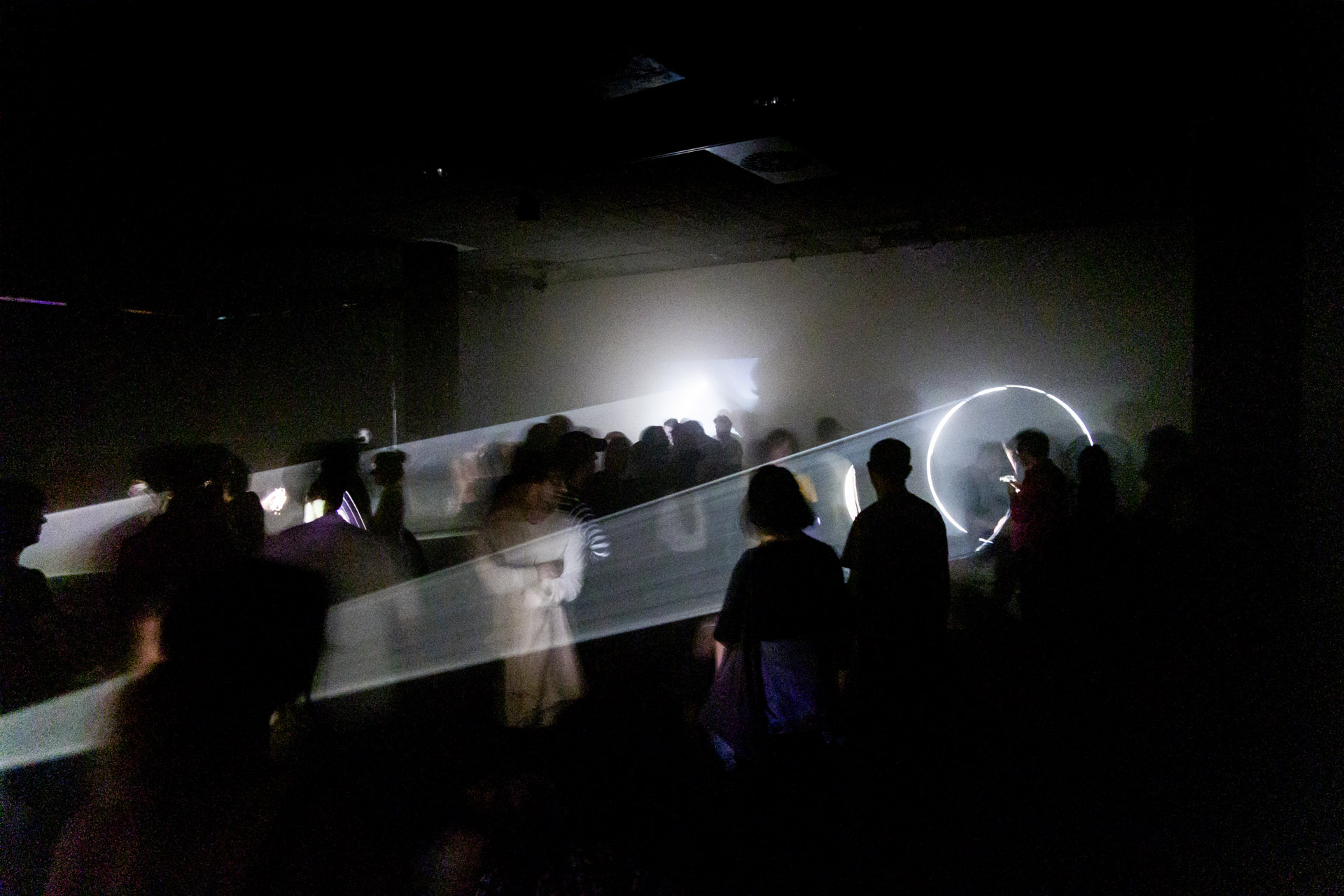
AS: Can you briefly talk about your drawings that are so integral to your work? I guess Drawing is an umbrella term that broadly describes what you were doing using pencil and paper, but there are all kinds of things in there, isn’t it?
AM: First an anecdote. You know, by the end of the 1970s when it became clear that I couldn’t support myself doing this, I began designing and editing art books, but that lasted over 20 years. During that period somehow, the work I had been doing in the 70s, things on paper, drawings etc got shoved to the bottom of flat file drawers and they remained there until Branden [W. Joseph] kept asking difficult questions when he was doing his research. So I kept exhuming stuff that I hadn’t seen in a long time. I was surprised to discover that when I had put them away, I put away a bunch of diagrams on graph paper, notes of numbers and structural ideas and so on. But when I took them out 25 years later, I was taking out drawings. I was so struck, how did that happen?! The transmutation had taken place in a magical moment where something turned into a drawing that hadn’t been a drawing before. Part of what may have happened is that by then within Conceptualism, we were all used to different kinds of notation and had an evolved sense of what is Drawing.
It is true that drawing is a palpable and explicit part of what I do. I have just archived all the notebooks, 160 of them, starting in the 1970s, there is a gap in the middle and then coming up to the present. They are full of drawings, numbers, words, notes, musings, quotes, the back matter is all stuff I could collect and find, putting them like a magpie and the front is all actual works I am developing. Now it’s got to a point where some of the works are getting quite complex and three dimensional and I simply can’t hold it all in my mind. So I developed a way of making three dimensional drawings, little models that I can turn around and move. And so that’s become sort of incorporated in my practice now. I don’t worry about it anymore. Some of them definitely are fine art drawings, others might be interesting though I would rarely call them a drawing.
AS: I wanted to touch upon a key compositional aspect of your work in some detail, a structuring interest in permutations, combinations and serializations. These aspects and their relationship to the minimal works of Robert Morris and post minimal works of Richard Serra or the conceptual works of Sol Lewitt have been considerably mined. You already mentioned the influence of Anthony Howell. I was thinking in terms of relationships to other films with a somewhat shared interest. Do you know Picture and Sound Rushes (1973) by Morgan Fisher?
AM: I don’t know that one, but I do know his Scratched Aspect Ratio pieces (2005) where he did all the academy shapes and sizes that you could have. He made them with mirrors and put them on the wall, so 4:3, 16:9 and so on, and he named them all.
Richard Serra’s Frame (1968) was an interesting film. Somehow or another he made films knowingly, let’s put it that way. Not necessarily like anyone else. He was interested in my Solid light works. I remember he stayed for the whole showing of Four Projected Movements, obviously getting a lot out of it, moving around and getting very involved. He got it, and he was always very supportive and helpful.
With Anthony Howell, we co-published along with some other artist friends, an artist book called Wallpaper, it was a magazine of our current works that no one would show otherwise, so we showed each other [laughs]. Later I discovered that Sol Lewitt had come to similar conclusions. He visited my studio very early on, which I am grateful for. I called him, asked to meet him and he came around. I remember we were looking at the 70s’ drawings when I did a long and extended photographic montage piece based on Le déjeuner sur l’Herbe. We were looking at all these drawings because every single permutation was diagrammed out, little hieroglyphs, and I said to Sol Lewitt, in order to realize all of it photographically, “I need to make 264 photographs and that’s pretty difficult”, and he said, “But do you have a choice?”. For him, the full realization of the logic of a piece was absolutely necessary. And in fact I agree with that. I tried to follow that but I haven’t had in the fullest sense a piece that had so many permutations. You probably noticed that I only ever used three forms in my films: a straight line, a circle or a wave.
AS: And the wave is probably more of a digital shape? I think it might be difficult to shoot with an animation camera.
AM: The wave form first appears in Doubling Back (2003), the first of the new films. It might have been possible to shoot with an animation camera, shooting 24 frames every hundredth of an inch but it would have been difficult. Some of the complexities I was able to explore only became possible in the digital medium. But those are the three shapes I work with, I don’t think there are any exceptions to that and partly because now the ideas are coming much more from the sculptural side of things, the three dimensional and durational aspects, rather than the purely visual.
AS: Which brings me to the next question, what other shifts in terms of scale and projection environments register in your work between what you were doing in the 1970s and after 2000?
AM: I was showing within the context of experimental or avant garde film in New York and the institutions were loft spaces like Millennium and Collective for Living Cinema, a scale of a room basically. The Vitruvian Man was the scale of the work, if the Vitruvian Man were half way down the beam, it meant about a 30 ft. throw. Once I started doing Long Film for Four Projectors, I began to have scale problems. I needed a 70 ft. room and I didn’t have any way of making that much beam visible. The dust in the air plus a few cigarette smokers worked for Line Describing a Cone but that didn’t do it for Long Film for Four Projectors. That’s when I really hit a brick wall. I went along and made the much simpler Four Projected Movements. I made elaborate diagrams that I used to send out to colleges that rented it showing how you get a film, you put sand in it, you put incense on it, you light the incense and you got a little smoke. I have still got those drawings. Then I discovered the haze machine. It was introduced to me in the mid 90s by a student of Birgit Hein who had come over for the summer to New York and insisted on organizing some film screenings including Line Describing a Cone and I said I don’t show it very often, its bit of a problem with visibility and he said, there is a great little smoke machine that has come out and he brought it to the performance. It was a revelation, it was a little dramatic but it made me realize that there is actually a way now of controlling visibility. That and a few other ideas led me back to making films. I had an essential dislike for video art but because of video art some of the galleries and occasionally museums had begun to take an interest in these kinds of works now. As a graphic designer I was already using computers. At the time, digital projection was very weak compared to film. I used high contrast film stock with xenon projection if possible and that blew away in terms of brightness the digital projectors, they weren’t very good at the beginning but kept getting better.
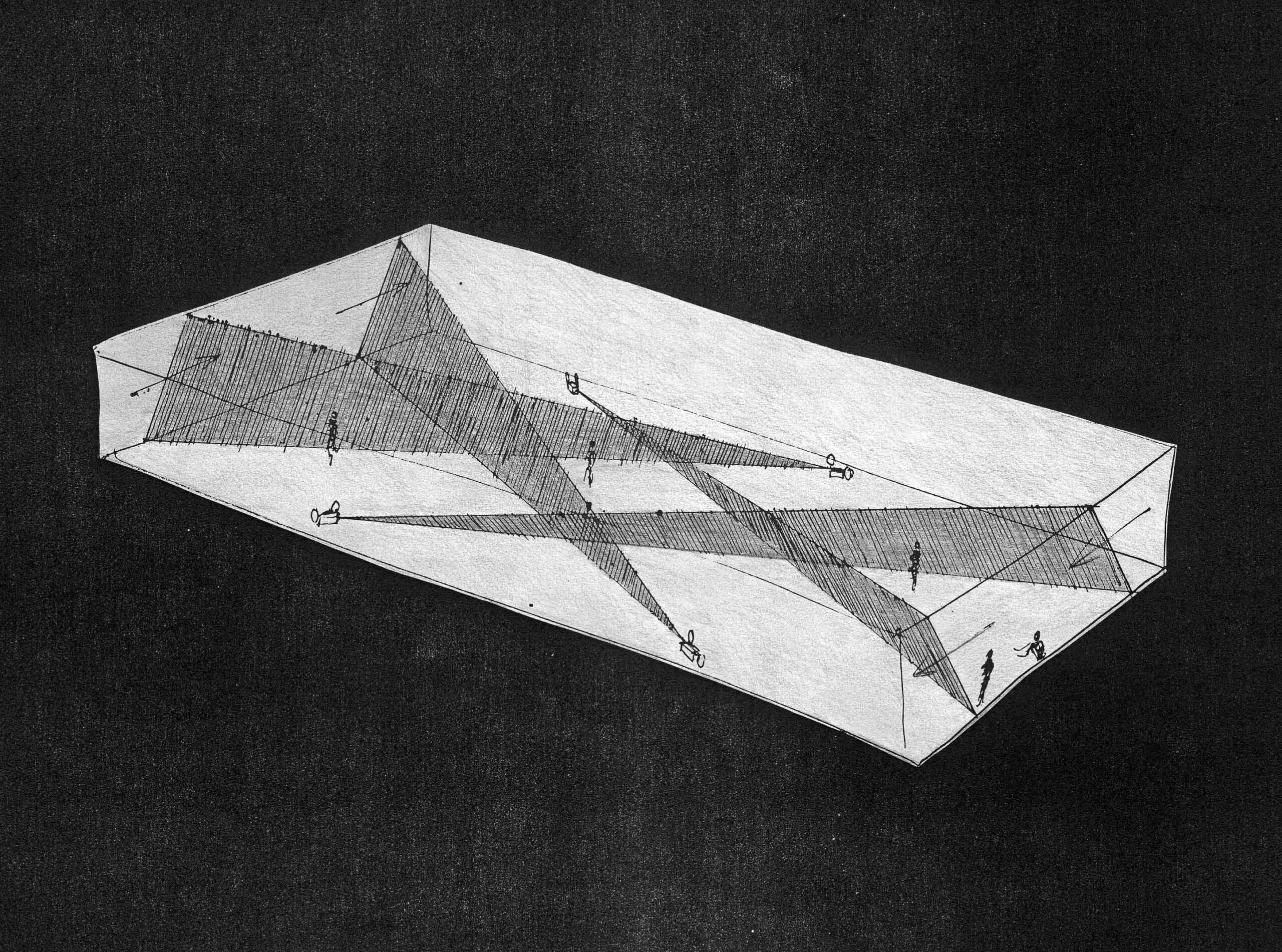
AS: Which is why early on, you had a 16mm print made of Doubling Back even though it was made digitally?
AM: Yes, the projections were weak and I needed the film for projection. It’s all very well to make it digital, which I was comfortable doing but then I took it to a lab and converted it to film so that I could show it “properly”. At the Whitney Biennale in 2004, I had a great big looper inside a box and I showed this film (loopers are a nightmare) and afterwards I thought that was complicated, maybe I should just bite the bullet and do it digitally. So I had the film converted back to digital and by then the digital projectors were getting a little bit better and I could show it satisfactorily though it was not particularly exciting. But then I realized how much money I had spent, five times as much money doing conversions than making the piece and that was ridiculous, it made no economic sense. So I went all digital at that point.
AS: And configurationally you also have these vertical pieces now which might be difficult with analogue projection.
AM: Impossible with analogue projection.
AS: But did you ever think of using mirrors?
AM: Yes you can put in a mirror, but that complicates the apex of the cone. Besides, if you try to put a heavy 16mm projector on a ceiling, even with a rig keeping it stable, the wheels would nearly fall off and probably the electromechanics wouldn’t work. Almost as soon as I was making vertical pieces, by the second or third piece, I thought that the digital projector was a grey box, it doesn’t matter where it goes. And I made the Breath series (2004), they became very important. I like the fact that you can circumnavigate the space, the space was free, the projector beam was out of reach, it was architectural light, there were tens of them or something and you had that feeling that they were inhabitable but not like one occupies a building. All kinds of new ideas came out of that and I still consider these vertical pieces very important and I continue to work on them.
AS: Let’s talk about something different. Could you recall some of the reactions to your presentation in Edinburgh in 1975, of Film as a Connective Catalyst.
AM: I had only discovered Marxist theory a year or two earlier and I was pretty new to it. It was a rather clumsy read I should think and provoked ire in the mind of Paul Sharits, who was a friend. He came up afterwards and said, this is war, it’s not what art is about! We were sharing an apartment, we went out that night drinking, it was quite interesting socially at the time [laughs]. But I don’t think the paper was particularly well received.
AS: It is very tempting to look at Argument (Anthony McCall and Andrew Tyndall, 1978) as some sort of decisive break in formal terms from the Solid Light Works, which it was, primarily in its use of mass media imagery. There is however a permutational and structural/cyclical interest extending to the typographic, the aural and the visual streams in Argument.
AM: Argument is a very formal film! We were trying to use different bits of the film language, we have image only, sound only, image and sound, text and image, text and sound and so on. We used all of the permutations. But I don’t think I will revisit these films (Argument and Sigmund Freud’s Dora (Anthony McCall, Andrew Tyndall, Jane Weinstock & Claire Pajaczkowska, 1979)) at all now, though they had their influence on what I did in the past. There is a politics to poetry and I believe in that more than I understand the discourses of Marxism.
Solid Light Works at S8 Mostra de Cinema Periférico, A Coruña, 2023, Image: César Seijas and Omar Rabuñal, Montage: Marcos Flórez
Interview by Arindam Sen
Disclaimer: This page is for your personal use only. It is not to be duplicated, shared, published or republished in whole or in part, in any manner or form, without the explicit permission of the publisher, author, and copyright holder(s) of the images.
